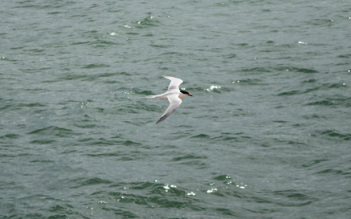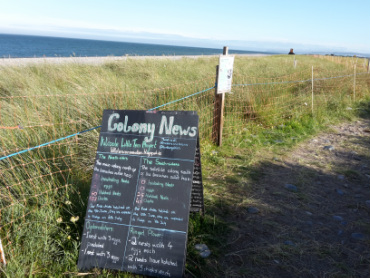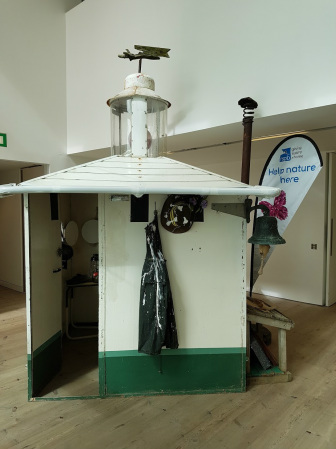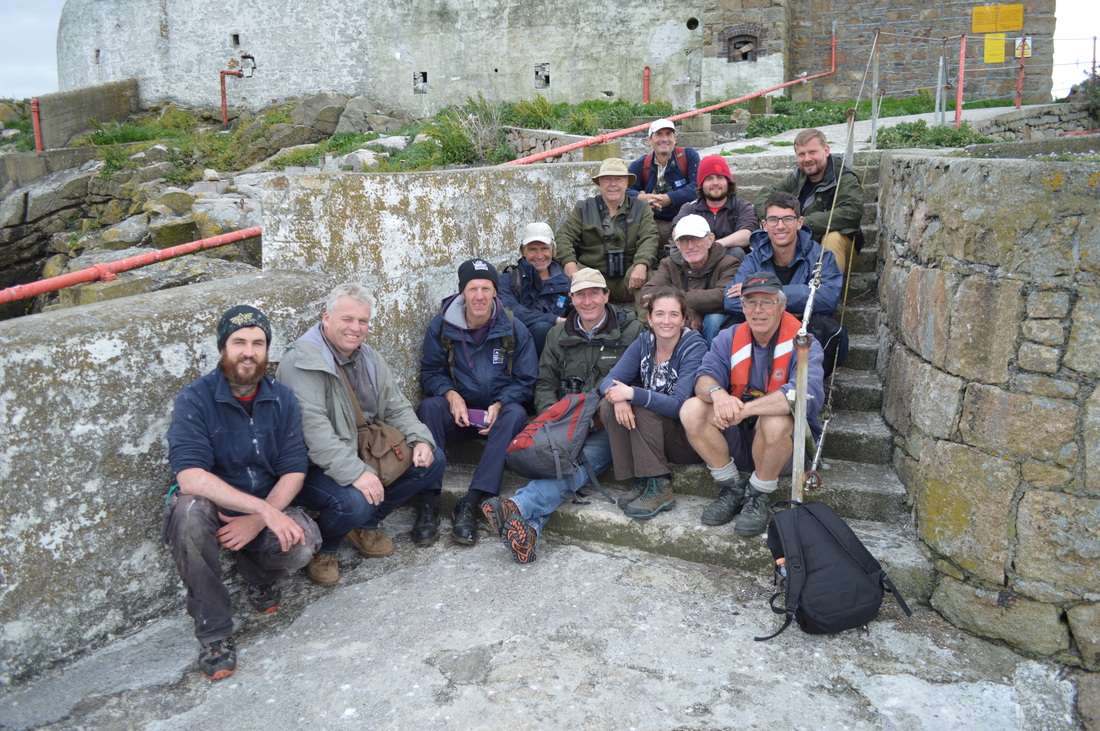 Roseate Tern (c) C Macleod-Nolan Roseate Tern (c) C Macleod-Nolan Like many migrating birds, roseate terns know no boundaries. This is what makes it is so important that the Roseate Tern LIFE project is a partnership covering multiple sites in different countries united in the aim to protect and expand the roseate tern breeding range in Britain and Ireland. Last week was a great example of international working with Daniel Piec and Chantal Macleod-Nolan, who are overseeing and coordinating the LIFE project on behalf of the RSPB, crossing the Irish Sea and visiting the project sites. Our first stop was Larne Lough in Northern Ireland where we were welcomed and met the warden and RSPB staff who are monitoring the area. Our resulting discussion was very insightful and along with actually seeing the site gave us with a much clearer understanding of how the site works and the breeding terns are doing this year. Throughout the visit we had some lovely sightings of fledgling Sandwich terns, common terns, black-headed gulls and black guillemots. Unfortunately with only one pair breeding at Larne Lough last year, roseate terns in Northern Ireland are facing extinction - making the support and funding the recovery project provides very important!  Lady's Island Lake in the mist (c) C Macleod-Nolan Lady's Island Lake in the mist (c) C Macleod-Nolan It was a misty start, but the weather improved and the next place to visit was Lady's Island Lake in the Republic of Ireland. It supports the second largest breeding colony of roseate terns in Ireland along with many other nesting birds including good numbers of Sandwich terns and common terns, which were busy returning with sand eels in their bill for their young. The site is managed by National Parks and Wildlife Services and it was great to hear that they have 202 pairs of roseate terns nesting there this year!  Kilcoole Little Tern Colony (c) C Macleod-Nolan Kilcoole Little Tern Colony (c) C Macleod-Nolan On our travels heading north we passed and dropped in to visit Kilcoole Little Tern Colony. Last year they had 155 nests, but how had they fared this year? Had they been affected by any factors that affect roseate terns as well? This year they had hatched 85 nests with 154 chicks, however the wardens have observed fox predation and poor food availability. The season is not over yet though and the site is currently still active (good numbers of little terns were flying about when we were there!). If you are interested in reading more about it, check out their blog: http://littleternconservation.blogspot.co.uk/  Dalkey Island (c) C Macleod-Nolan Dalkey Island (c) C Macleod-Nolan Dalkey Island was next and as we mentioned in a previous blog it is an important area for roosting roseate terns with intermittent breeding attempts. We were eager to meet with the new Dalkey warden (BirdWatch Ireland) and discuss how the nesting Arctic and common terns were faring this year and if any passing roseate terns had shown an interest in the newly placed nest boxes. Understanding the pressures these nesting terns are facing is important and if they are doing well, it may attract roseate terns who have a preference for nesting among other tern species. It was also nice to hear about how Tuesday's Dalkey Tern Watch have been going - great 'tern' out if you can pardon the pun!  Roseate Terns (c) C Macleod-Nolan Roseate Terns (c) C Macleod-Nolan Last but definitely not least was Rockabill Island, home to the largest roseate tern colony in North West Europe. This year they have 1556 roseate tern nests! We were joined on this trip by wardens and staff from a number of Tern colonies in Northern Ireland and Wales (RSPB & NWWT) and were shown around by Rockabill warden Brian Burke (BirdWatch Ireland): http://rockabillterns.blogspot.co.uk/. In addition earlier in the week Rockabill Island also hosted the RSPB wardens from Coquet Island, England as well. With added funding from the project, the wardens were able to start slightly earlier and prepare for the season controlling the vegetation and providing terns with more nesting opportunities! Currently the wardens are busy monitoring the nesting terns, observing predation and undertaking provisioning studies. I would like to thank all the wardens and staff who took the time to show us around their sites. Not only was it a fantastic opportunity to observe breeding roseate terns and their interactions, but all of these site visits and informal discussions are incredibly important with each site having their own intricacies and management approaches regarding their different breeding species, disturbance and predators. Exchanging knowledge and experiences potentially offer new solutions and allow us to return to our own sites/offices with renewed eagerness to continue protecting these rare birds!!!
0 Comments
 Roseate Terns on Coquet LIVE (c) RSPB Roseate Terns on Coquet LIVE (c) RSPB Roseate terns and Coquet Island have been making headlines in the news lately and here is the explanation on why that is. As mentioned in one of our previous blog posts – an exceptional event happened with Coquet Island’s rare breeding roseate terns along with their puffin friends becoming stars with their own live camera feed. To prevent unnecessary disturbance to these rare breeding seabirds, public access is prohibited to the island. Thanks to support from the LIFE Programme of the European Union and the Northumberland Coast Area of Outstanding Natural Beauty Sustainable Development Fund, Coquet Island is now the first ever roseate tern colony streaming live camera footage and it is being streamed on the internet for the whole world to see! Wesley Davies, resident warden on RSPB Coquet Island, said: “We wanted to be able to share these amazing birds with the public, but what we didn’t realize is that the cameras give better views than we get on the island – with the advantage of not getting pecked.” “It’s amazing watching the secret lives of puffins and roseate terns – they get up to more than we ever thought.”  Night Hide at the BALTIC (c) Daniel Piec Night Hide at the BALTIC (c) Daniel Piec Another amazing experience for the public occurred when a piece of Coquet Island was transplanted to Gateshead Baltic Arts Centre in Newcastle during ‘Creative Conservation Week’ in June! The week included the island’s newly launched live webcam, informative and engaging art activities for youngsters and a witness the full immersive experience of 360 virtual reality of the puffin colony filmed on Coquet Island! This impressive piece of technology, filmed by Edinburgh Napier University, allows you to get as close to being a puffin as possible and it really does makes you feel as if you were standing on the island. One of the main attractions of this event was the night hide which has sheltered the RSPB wardens for 10 years during their 24 hour watches protecting the rare birds against egg thieves! The night hide was made by award-winning blacksmith Stephen Lunn from Northumberland and the 6ft-by-6ft structure mimics the appearance of the lighthouse on Coquet Island. Throughout the 10 years, this hide fended off the North Sea and weather; however it took its toll and eventually needed to be replaced. As a result the wardens now have a bigger hide, which has the luxury of glass panes in the windows, a new wood-burner and spins on its base to give an all-round field of vision. “The old hide gave us 10 good years of service and we hope that the Baltic is not its last foray,” said Wesley. “It went down very well with visitors at the festival in London and its appearance at the Baltic event will give people a taste of what life is like on the island.”  Fantastic artwork at the Baltic event courtesy of the youngsters that visited (c) Daniel Piec Fantastic artwork at the Baltic event courtesy of the youngsters that visited (c) Daniel Piec Sources: Roseate terns and puffins are captured on live camera feed: http://www.northumberlandgazette.co.uk/news/local-news/roseate-terns-and-puffins-are-captured-on-live-camera-feed-1-7932816#ixzz4DRpllsTE Piece of Coquet Island transplanted to Gateshead Baltic arts centre: http://www.chroniclelive.co.uk/news/north-east-news/piece-coquet-island-transplanted-gateshead-11410995 There is also a great post on the RSPB Community page by RSPB Principal Policy Officer Euan Dunn. Coquet Night Hide Adventures – Bringing the UK’s rarest nesting seabird to the mainland: http://www.rspb.org.uk/community/ourwork/b/biodiversity/archive/2016/06/23/coquet-night-hide-adventures-bringing-the-uk-s-rarest-nesting-seabird-to-the-mainland.aspx |
More Blogs to Read
AuthorThis blog is maintained by various people from the project team. Archives
August 2020
Categories
All
|
Roseate Tern LIFE Project is supported by the LIFE Programme of the European Union
LIFE14 NAT/UK/000394 ROSEATE TERN
LIFE14 NAT/UK/000394 ROSEATE TERN





 RSS Feed
RSS Feed